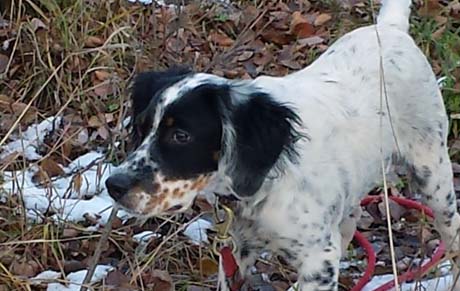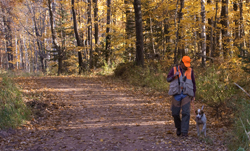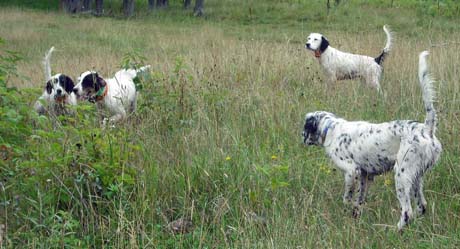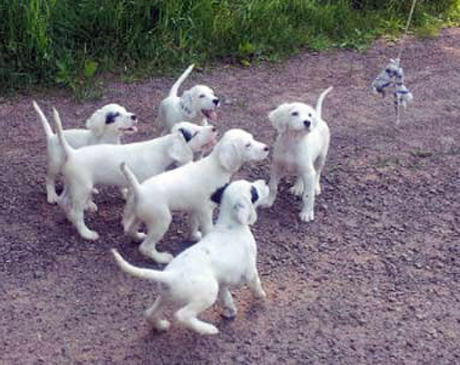The pointing instinct

Puppy points can be intense. Dixie (Houston’s Blackjack x Northwoods Highclass Kate, 2013) is utterly focused on bird scent.
The excitement associated with seeing a dog on point is likely what attracted most pointing dog owners. What is the pointing instinct, exactly, and how does it develop?
The pointing instinct.
Pointing is defined as freezing at the scent or sight of game. It is an inherited instinct most prominent in the pointing breeds but, to some degree, many sporting breeds and wild animals also display the pointing instinct.
Two terms are frequently used to describe points. Staunchness refers to how long the dog holds point while steadiness describes a level of training, i.e., steady-to-wing or steady-to-wing-and-shot.
Puppy points.
A puppy’s first points are usually an instinctive response to the smell of game. These points are often called “flash points” and are short in duration. Some puppies, though, do point for a longer time because they’re unsure and aren’t bold enough to rush in. During these early points, the puppy is in a heightened state of emotion, its body posture intense and sometimes crouched as it focuses exclusively on the smell.
As a puppy learns what it is smelling, it points and then stalks toward the location of scent until it gets close enough to flush the bird. The puppy chases to try to catch the bird. This continues until the puppy realizes it can’t catch the bird and, therefore, its only alternative is to hold point. As the puppy becomes more experienced in pointing, the excitement wanes and its pointing stature begins to convey confidence and boldness.
Developing point.
To properly develop a young pointing dog, it should be allowed to learn how to handle birds without interference. The best method is frequent bird (wild or liberated birds that can’t be caught) contacts. Two of the most important lessons are learned at this stage—how close the dog can get to the bird before the bird flushes and that the dog’s movement causes the bird to flush. (For more information, please view the post Accuracy of location.)
There is nothing the handler can do—or should do—to rush this phase. While the puppy is pointing, don’t talk to or restrain it and don’t be in a hurry to flush the bird.

By the age of two, Northwoods Carly Simon (Blue Shaquille x Houston’s Belle’s Choice, 2011) was fully trained, i.e., was steady-to-wing-and-shot. On a Georgia quail plantation, she displays the quintessential pointing posture–beautiful and confident.
Staunchness and steadiness training.
At some time, and after enough bird contacts, most well-bred pointing dogs naturally stay on point until the handler arrives. This is the minimum expected (the hunter needs to be close enough to shoot the bird) and is referred to as a staunch point or staunchness.
The next step is steadiness training. Many pointing dogs are trained to be steady to the flush of a bird, also called steady-to-wing. Very few are trained to the ultimate level–steady-to-wing-and-shot.
Pointing problems.
Faulty genetics, improper development, bad training or a combination can cause problems with pointing. Here are some of the most common and their causes.
Blinking
The dog smells the bird but then avoids it and continues on. This is almost always a man-made fault from improper development around game. While some dogs may be soft tempered by nature, no dog is born a blinker.
Bumping
Whether before or after pointing, the dog intentionally jumps in and causes the bird to flush. This is fine in a young dog but should not be allowed in a mature dog. These are usually bold, aggressive dogs that need to be corrected.
Circling
The dog smells the bird and maybe points but then tries to move around the bird instead of going directly towards it. In a mature, experienced wild bird dog, this behavior might be a learned response to stop birds from running away from its points. Circling in a young dog, however, is more likely an inherited behavior but could be caused by improper training and development.
Flagging
The dog points the bird but its tail wags and never stiffens. This can be inherited and/or man made.
Laying down
A dog points with low posture or even lies down on point shows a lack of boldness towards the bird and/or doesn’t want the bird to flush. This can be inherited and/or man made.
Unproductive points
The dog points and but no bird is flushed. Again, this can be inherited and/or man made. (For more information, please view the post Unproductive points.)
Final thoughts.
• Sight points are not the same as scent points. The old “wing on a string” trick so often used to pick a pointing dog puppy means nothing regarding future scent-pointing ability.
• All dogs will tend to point longer as they get older. Too, they get more cautious in the presence of game.
• There is “too much point” and “not enough point.” Ideally, the young dog will have enough genetic point to stop but learn staunchness through bird contacts.
• A precocious puppy with excessive staunchness doesn’t always turn into the best wild bird dog in the end.






